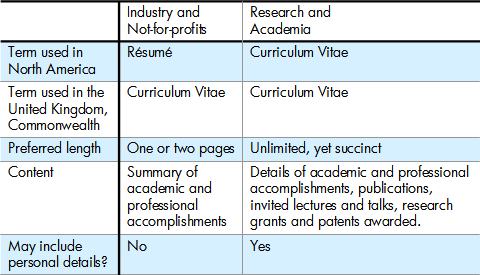The terms résumé or curriculum vitae (CV) are near-synonyms and often used interchangeably. The sense of these terms, however, may differ in certain geographies.

Usage in North America
In North America, there is a difference between the terms résumé and curriculum vitae in terms of the target audience, purpose and length.
The term résumé refers to a concise summary of a candidate’s credentials for the purpose of seeking employment in industry or the non-profit sector. A résumé, therefore, primarily summarizes the candidate’s educational background and professional experience. The preferred length of a resume is one or two pages.
A curriculum vitae is a more exhaustive record of a candidate’s qualifications and achievements primarily for seeking positions in academia and research. A curriculum vitae may include publications, fellowships and scholarships, invited lectures and talks, research grants and patents secured, etc. Some curriculum vitae contain personal details as well. Generally, there is no page-limit on a curriculum vitae. For an example, see the curriculum vitae of Donald Knuth, computer science pioneer and Professor Emeritus at Stanford University.
Usage in the United Kingdom and Commonwealth
In the United Kingdom and members of the Commonwealth, the term curriculum vitae is used for seeking employment in industry, the non-profit sector, academia or research. The term résumé is not traditionally used. The format and length of the curriculum vitae depends on the target of the curriculum vitae (industry/not-for-profit or research/academia) as in North America.
Usage in Other Countries
In some countries–India and Australia, for example–the terms résumé and curriculum vitae may be used interchangeably. In India, the term ‘bio-data’ refers to a résumé as well.
Choice between Résumé and Curriculum Vitae
Write your résumé or curriculum vitae to suit the preferred style and format of your target audience (industry or academia) irrespective of what the document is termed.
Do not include the word ‘Résumé’ or phrase ‘Curriculum Vitae’ at the top of your document—use the valuable space to enhance your document either by adding further details of your accomplishments or by increasing white space around various sections of your résumé to make it more visually appealing.



